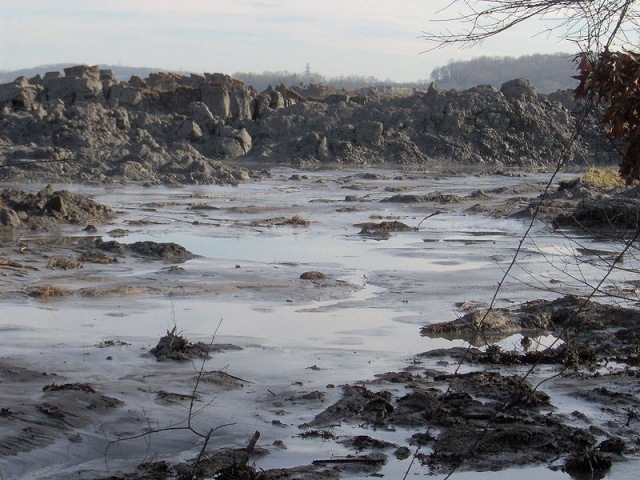The Environmental Protection Agency released long-awaited coal ash regulations today, the first rules ever to be imposed on the storage and disposal of the toxic waste left over after burning coal for electricity—the second largest industrial waste stream in the U.S.
But according to Earthjustice and the 10 environmental and public interest groups it represented in suing to force the release of the regulations in the first place, the EPA’s new rules are not nearly stringent enough to stop the next coal ash spill before it happens.
The new rules will not phase out the practice of storing massive quantities of coal ash—which contains highly toxic substances like arsenic, mercury, lead and radioactive uranium—in unlined ponds shored up by earthen dams that are often unstable and likely to fail. This is exactly what happened in the case of the Dan River coal ash spill in North Carolina this past February and the spill in Kingston, Tennessee in 2008 that released 1.1 billion gallons of coal fly ash slurry, covering up to 300 acres of surrounding land.
The typical coal ash dam is built from soil and ash and is used to impound millions of tons of coal ash and wastewater. The majority are over 40 years old, according to Earthjustice, and most do not have monitoring systems in place for detecting leaks of the toxic coal ash slurry they contain.
It’s not just that coal ash ponds are prone to catastrophic failure: Lisa Evans, Senior Administrative Counsel for Earthjustice, also said in a statement that the new regulations “won’t stop the slower moving disaster that is unfolding for communities around the country” as the unlined ponds continually leak their toxic contents into nearby rivers, lakes, streams and underground sources of drinking water.
The EPA says there are 1,070 coal ash ponds and over 400 landfills in the U.S. used as coal ash waste dumps. There have been more than 200 documented cases of contamination of water supplies in 37 states, all of which are posted on Earthjustice’s website.
Previously proposed versions of the new EPA rule would have phased out unlined coal ash storage ponds, Evans told DeSmog.
“EPA‘s 2010 proposed subtitle C rule would have phased out unlined coal ash ponds, period. EPA‘s proposed subtitle D rule would have also phased out unlined coal ash ponds by requiring closure or retrofit within 5 years.” But after industry pressure, “EPA retreated from this requirement in the final rule.”
The EPA’s rules set new standards for where new coal ash tanks can be sited in order to protect local groundwater supplies and set higher structural integrity standards for new and existing coal ash ponds and landfills. They also require monitoring of new and existing coal ash storage sites for contamination of groundwater, and would force operators to provide public information about standards at coal ash impoundments.
Because the EPA ultimately designated coal ash as household waste and not hazardous waste, however, it will be up to local governments to see the new standards are carried out.
“While these rules put forward clean-up and safety standards to protect communities, the EPA is leaving oversight and enforcement almost entirely to the states,” Traci Barkley, Water Resources Scientist with Prairie Rivers Network, said in a statement. “Illinois has over 90 aging coal ash pits with coal ash pollutants found in the groundwater near every one. Communities rely on at-risk rivers and groundwater for drinking water, recreation, and business.”
“This power industry has had half a century or more to clean up its act,” Earthjustice’s Evans said, “but even in the face of huge spills and a terrible record of proven water contamination around the country, it is still dumping ash in huge unlined pits. These dumps aren’t going away by themselves, and unfortunately under today’s rule, EPA is putting the burden on citizens to get them safely closed.”
By some estimates, there are 140 million tons of coal ash produced in the U.S. every year. Which begs the question: Can this massive waste stream be disposed of in an environmentally sound manner?
According to Earthjustice’s Evans, there are certainly better ways to dispose of it than what the new EPA regulations will require:
“While there are always some problems that arise with waste disposal, the safest way to dispose of coal ash is in a dry, lined engineered landfill, with monitoring wells and a leachate collection system. Recycling into concrete is also a safe way to get rid of the ash. Not generating coal ash in the first place is the most environmentally safe solution.”
Image Credit: “View of the TVA Kingston Fossil Plant fly ash spill, appx. 1 mile from the retention pond” by Brian Stansberry / Wikimedias Commons
Subscribe to our newsletter
Stay up to date with DeSmog news and alerts






